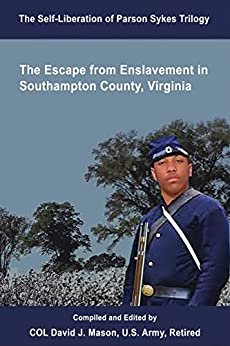
Publisher:
Hmg Epublishing LLC
Publication Date:
N/A
Copyright Date:
N/A
ISBN:
9780999133118
Binding:
Paperback
U.S. SRP:
19.99
THE SELF-LIBERATION OF PARSON SYKES
By David J Mason


- Posted by Craig J
- |
Parson Sykes was a former slave who escaped from his owner in 1864, joined the Union Army, and served in the final days of the American Civil War. This story would be remarkable enough, but for the fact that the only reason we know of it is that the details of Sykes’ “self-liberation” – as author (and Sykes’ great-grandson) David J. Mason puts it – have been passed down from family member to family member for over 150 years.
Sykes was born into slavery in Virginia, but he was a man of many talents, so much so that his owner, one Jacob Williams, hired him out to the Boykins Depot near Cross Keys, where the plantation on which Sykes worked was situated. While there, he surreptitiously fished old newspapers out of trash cans, and studied them little by little in an abandoned house nearby, devouring stories about successful slave escapes, and making preparations for his own. In December 1864, Sykes and his two brothers struck out for the Union lines. Once they reached them, they promptly enlisted, becoming members of the First Cavalry Regiment, United States Colored Troops.
THE SELF-LIBERATION OF PARSON SYKES is billed as historical fiction, but in all honesty it reads more like a work of popular history. Aware of the incongruity, Mason describes the work as a “documentary novel”, and the text is indeed heavy on historical detail that is often only tangentially related to Sykes’ story; such details about his life as have survived in the family’s oral tradition are embedded in this framework, rather than constituting the whole affair. It is an editorial decision made out of necessity. As Mason points out, what is known of Sykes is almost all encapsulated in the oral tradition. But it does have the side effect of requiring Mason to include substantial incidental material on the nature of the war, including straightforward narratives about Sherman, Grant, and Lee, the nature of work on the railroads, and the political consequences of Lincoln’s war legislation regarding slaves and the institution of slavery.
None of this militates against the importance of Sykes’ experience. By all accounts, he was a remarkable man, one who learned early to shield his own growing sense of identity and self-determination from his overseers, even as it was being fed by the tidbits of information that came him his way on the yellowing pages of discarded newspapers and the like. His escape was meticulously planned and risky in the execution, yet successful, and the moment of his enlistment – in spite of the inferior pay for blacks, the casual racism that still abounded, and the myriad ways in which middlemen and con artists attempted to rip them off during the recruitment process – is treated with something approaching reverence, as it should be. Sykes and his brothers, Mason relates, found these to be “breathtaking moments”, ones in which, for the first time, they felt equal to whites.
THE SELF-LIBERATION OF PARSON SYKES is a tale that deserves a wider audience. Sykes’ story is to be continued in a second volume, and it will be fascinating to learn more of the contours of his life after the Civil War came to an end. (It would also be interesting to get more of an impression of how the story was transmitted from one generation to another, a process that itself has been the subject of many recent books and memoirs.) One wrinkle in this volume, however, is the comparatively large number of typesetting and typographical errors. The settlement of Cross Keys is rendered as Cross Key on page 2; a sentence about the abolitionists on page 34 is repeated almost exactly word for word a page later; on page 39, black troops are described as having “helped to help to win” the war – surely not the intended meaning; on page 47, Sykes’ intention to “self-liberate himself” is advanced; and so forth. There are also quite a few instances of overcapitalization as well as a sprinkling of punctuation errors. Taken together, these can distract the reader somewhat, and it is to be hoped that they will be rectified in future volumes.
Written by the protagonist’s great-grandson David J. Mason, THE SELF-LIBERATION OF PARSON SYKES is a compelling book which covers the early life of Parson Sykes, who escaped slavery and served in the Union Army during the American Civil War, and whose story has been transmitted through several generations of his descendants.
~Craig Jones for IndieReader

Publisher:
Hmg Epublishing LLC
Publication Date:
N/A
Copyright Date:
N/A
ISBN:
9780999133118
Binding:
Paperback
U.S. SRP:
19.99

- Posted by Craig J
- |
Author David J. Mason–the title subject’s great grandson–describes the brutality of slavery and the importance of determination in THE SELF-LIBERATION OF PARSON SYKES, an inspirational journey from slavery to freedom. The significant role of the United States Colored Troops in the war is highlighted and Sykes’ story is a reminder that all humans, irrespective of caste and creed, deserve equal rights. Highly recommend for those interested in history, culture, and the Civil War.

THE SELF-LIBERATION OF PARSON SYKES
David J Mason
Hmg Epublishing LLC
9780999133118
Rated 4.1 / 5 based on 1 review.